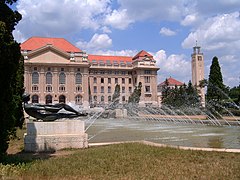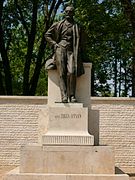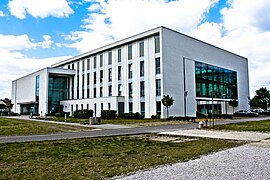
The University of Copenhagen is a prestigious public research university in Copenhagen, Denmark. Founded in 1479, the University of Copenhagen is the second-oldest university in Scandinavia after Uppsala University, and ranks as one of the top universities in the Nordic countries, Europe and the world.

Debrecen ( DEB-rət-sen, Hungarian: [ˈdɛbrɛt͡sɛn] is Hungary's second-largest city, after Budapest, the regional centre of the Northern Great Plain region and the seat of Hajdú-Bihar County. A city with county rights, it was the largest Hungarian city in the 18th century and it is one of the Hungarian people's most important cultural centres. Debrecen was also the capital city of Hungary during the revolution in 1848–1849. During the revolution, the dethronement of the Habsburg dynasty was declared in the Reformed Great Church. The city also served as the capital of Hungary by the end of World War II in 1944–1945. It is home to the University of Debrecen.
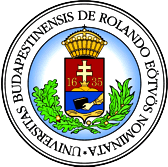
Eötvös Loránd University is a Hungarian public research university based in Budapest. Founded in 1635, ELTE is one of the largest and most prestigious public higher education institutions in Hungary. The 28,000 students at ELTE are organized into nine faculties, and into research institutes located throughout Budapest and on the scenic banks of the Danube. ELTE is affiliated with 5 Nobel laureates, as well as winners of the Wolf Prize, Fulkerson Prize and Abel Prize, the latest of which was Abel Prize winner László Lovász in 2021.

The University of Szeged is a public research university in Szeged, Hungary. Established as the Jesuit Academy of Kolozsvár in present-day Cluj-Napoca in 1581, the institution was re-established as a university in 1872 by Emperor Franz Joseph I. The university relocated to Szeged in 1921, making it one of the oldest research universities in Hungary. It went through numerous changes throughout the 20th century and was eventually divided into distinct independent universities.

Semmelweis University is a research-led medical school in Budapest, Hungary, founded in 1769. With six faculties and a doctoral school it covers all aspects of medical and health sciences.

University of Erlangen–Nuremberg is a public research university in the cities of Erlangen and Nuremberg in Bavaria, Germany. The name Friedrich–Alexander comes from the university's first founder Friedrich, Margrave of Brandenburg-Bayreuth, and its benefactor Alexander, Margrave of Brandenburg-Ansbach.

The University of Pécs is an institution of higher education in Hungary. The modern university was established in 1912 but has its roots in the medieval university founded in Pécs in 1367 by King Louis I the Great. A total of 20,000 students presently attend the University of Pécs, approximately 4,500 of whom are international students studying in English or German.

Pázmány Péter Catholic University (PPCU) is a private university in and near Budapest, Hungary, belonging to the Catholic Church and recognized by the state. Founded in 1635, the PPCU is one of Hungary's oldest and most prestigious institutions of higher education.
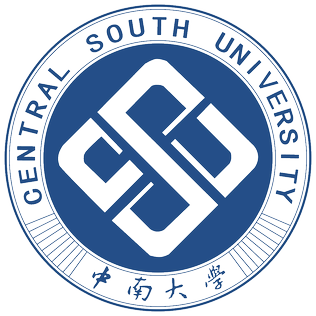
Central South University is a national public university in Changsha, Hunan, China. The university is sponsored by the China Ministry of Education. It is a Chinese state Double First Class University. Hunan Medical University, Changsha Railway College, and Central South University of Technology merged to establish Central South University in April 2000.
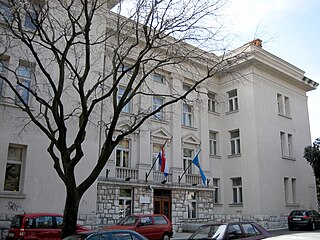
The University of Rijeka is in the city of Rijeka, Croatia, with faculties in cities throughout the regions of Primorje, Istria and Lika.

Földes is a large village in Hajdú-Bihar County, in the Northern Great Plain region of eastern Hungary.

Institute of Psychology of the University of Szeged, Szeged, Hungary, is located at 2 Egyetem Street, at the Szeged University Campus of the Faculty of Arts. The Institute of Psychology in Szeged is the longest-standing psychology institute in Hungary.

The Ferenc Kölcsey Teacher Training College of the Reformed Church of Hungary had its roots in the Debrecen College of the Reformed Church. In 2011, the college integrated into Debrecen Reformed Theological University.
The Debrecen Reformed Theological University, in English translation also known as Debrecen University of Reformed Theology is the successor of the Debrecen Reformed College. The University is one of the Hungarian centers for Protestant theological training, with a major interest in training ministers for the Reformed Church in Hungary. In September 2011 the Ferenc Kölcsey Teacher Training College of the Reformed Church was integrated into the University.

The Eszterházy Károly Catholic University (-2021-08-01) was founded in 1774 in Eger. In 1989 it was renamed after its founder Bishop Károly Eszterházy. Number of students is 8602.
Lajos Kemény is a Hungarian dermatologist, venereologist, allergologist, medical researcher, full professor and the Head of the Department of Dermatology and Allergology, the director of the Albert Szent-Györgyi Health Center, Faculty of Medicine, University of Szeged and the Vice-Rector for Science, Research Development and Innovation. He is a notable and respected scientist both in Hungary and around the world.

The Faculty of Science of Eötvös Loránd University was founded in 1949 and it is located in Lágymányos Campus, Újbuda, Budapest, Hungary.

The Faculty of Humanities is the oldest faculty of Eötvös Loránd University and is located on the institution's Trefort Garden campus in Józsefváros, Budapest, Hungary. It was founded by the Cardinal Archbishop of Esztergom Prince Primate of Hungary, Péter Pázmány, in 1635.

The Faculty of Law of Eötvös Loránd University was founded in 1667 and it is located in Egyetem tér in Belváros-Lipótváros, Budapest, Hungary.









